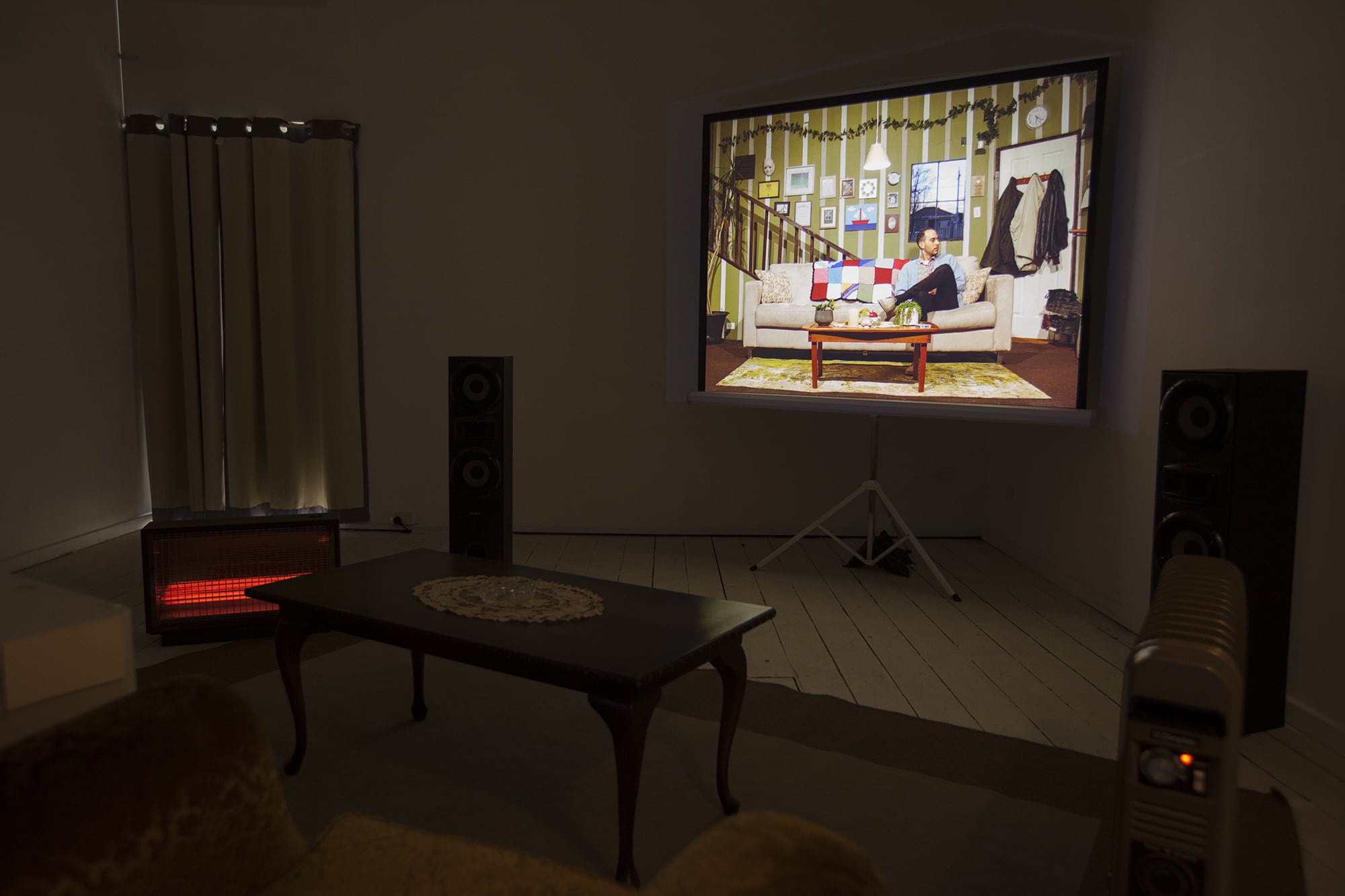
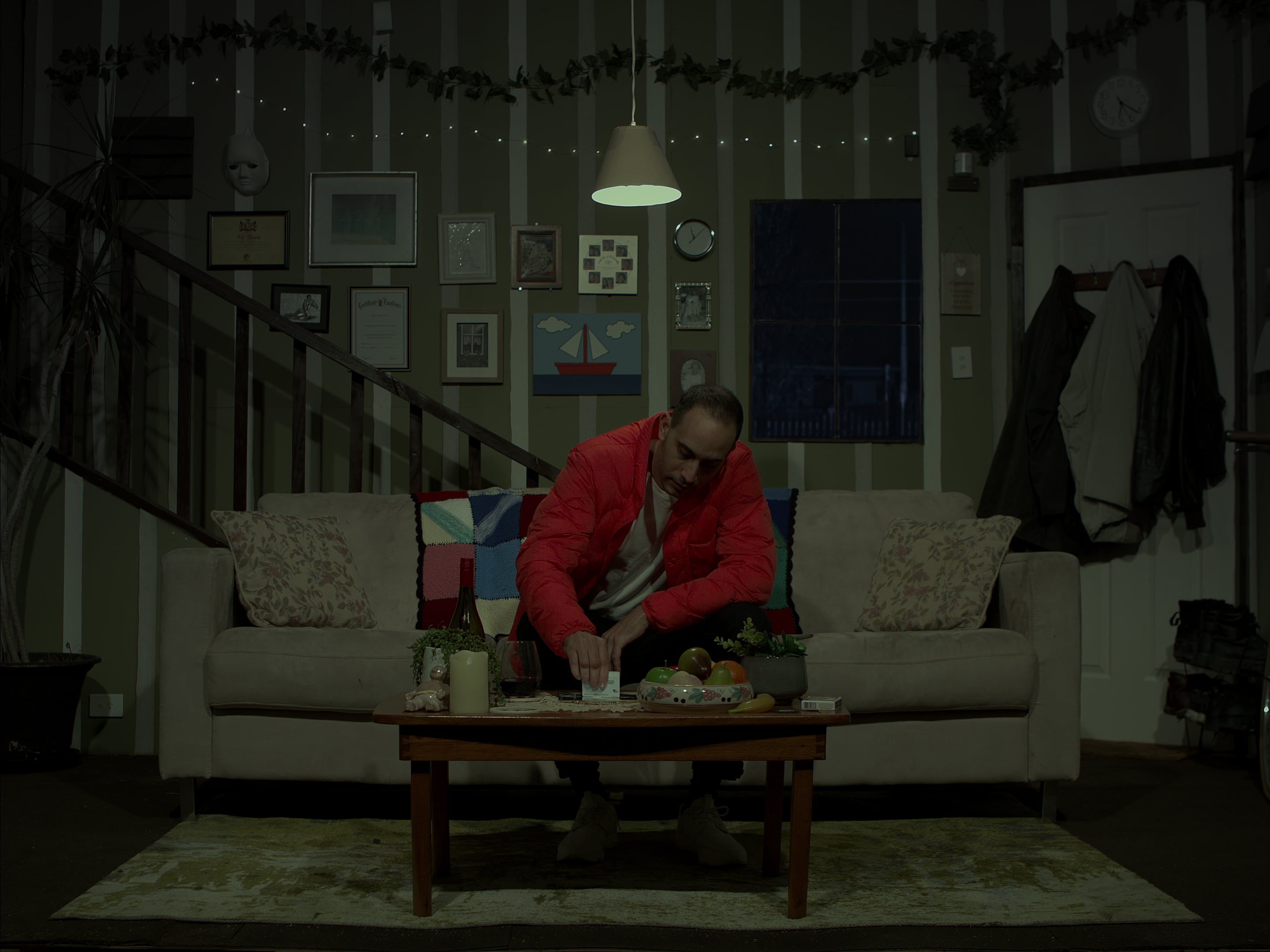
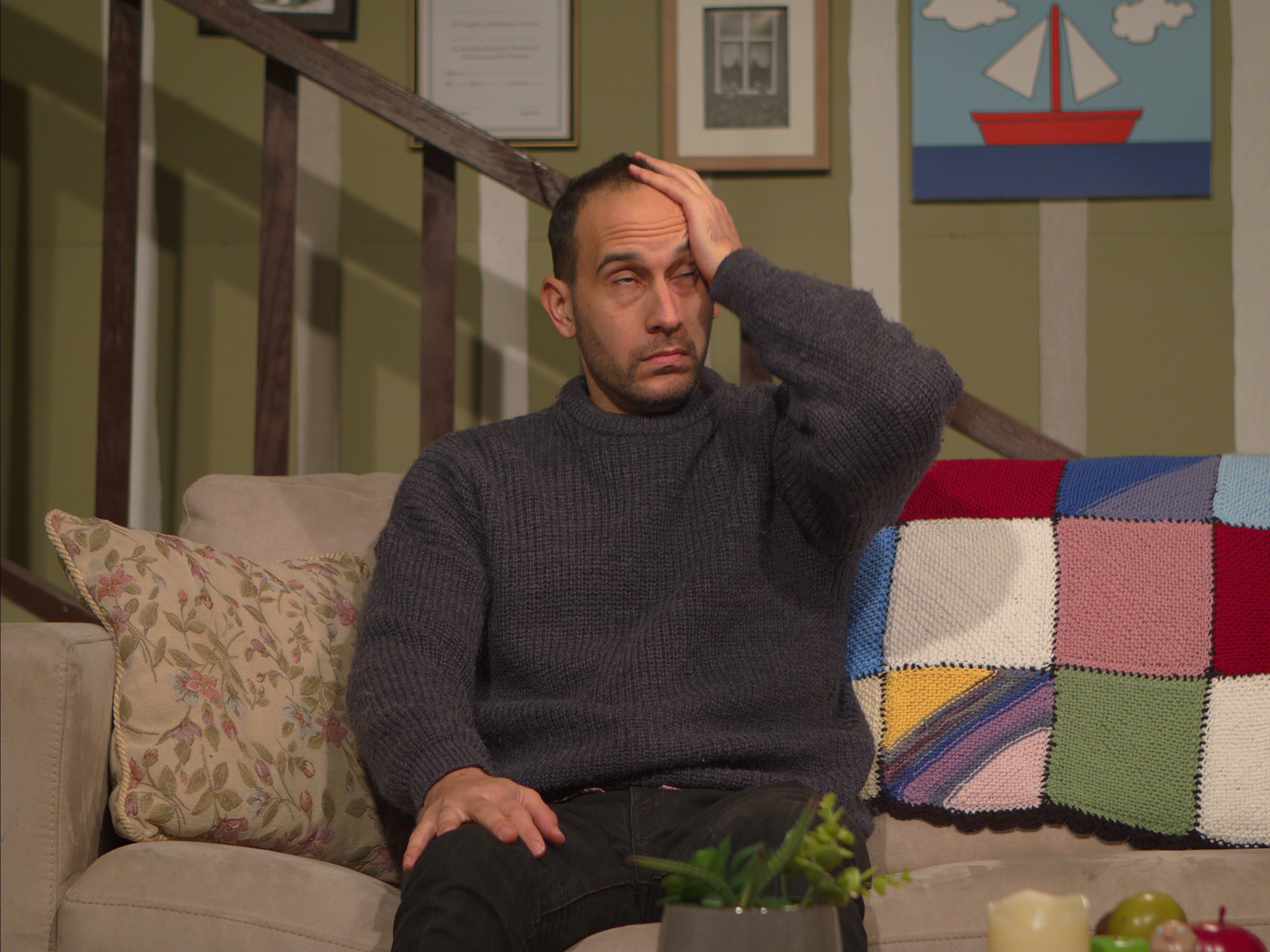
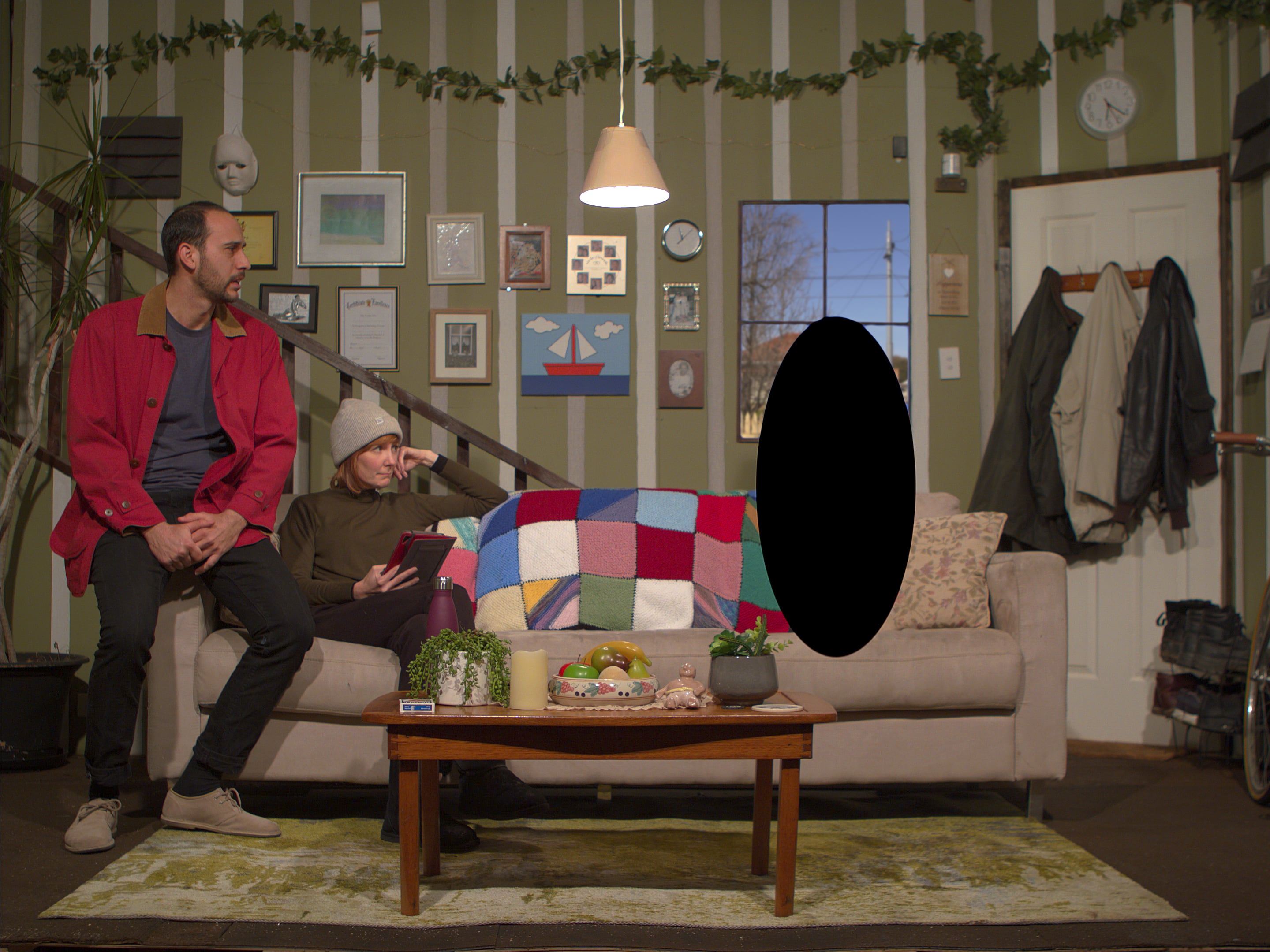
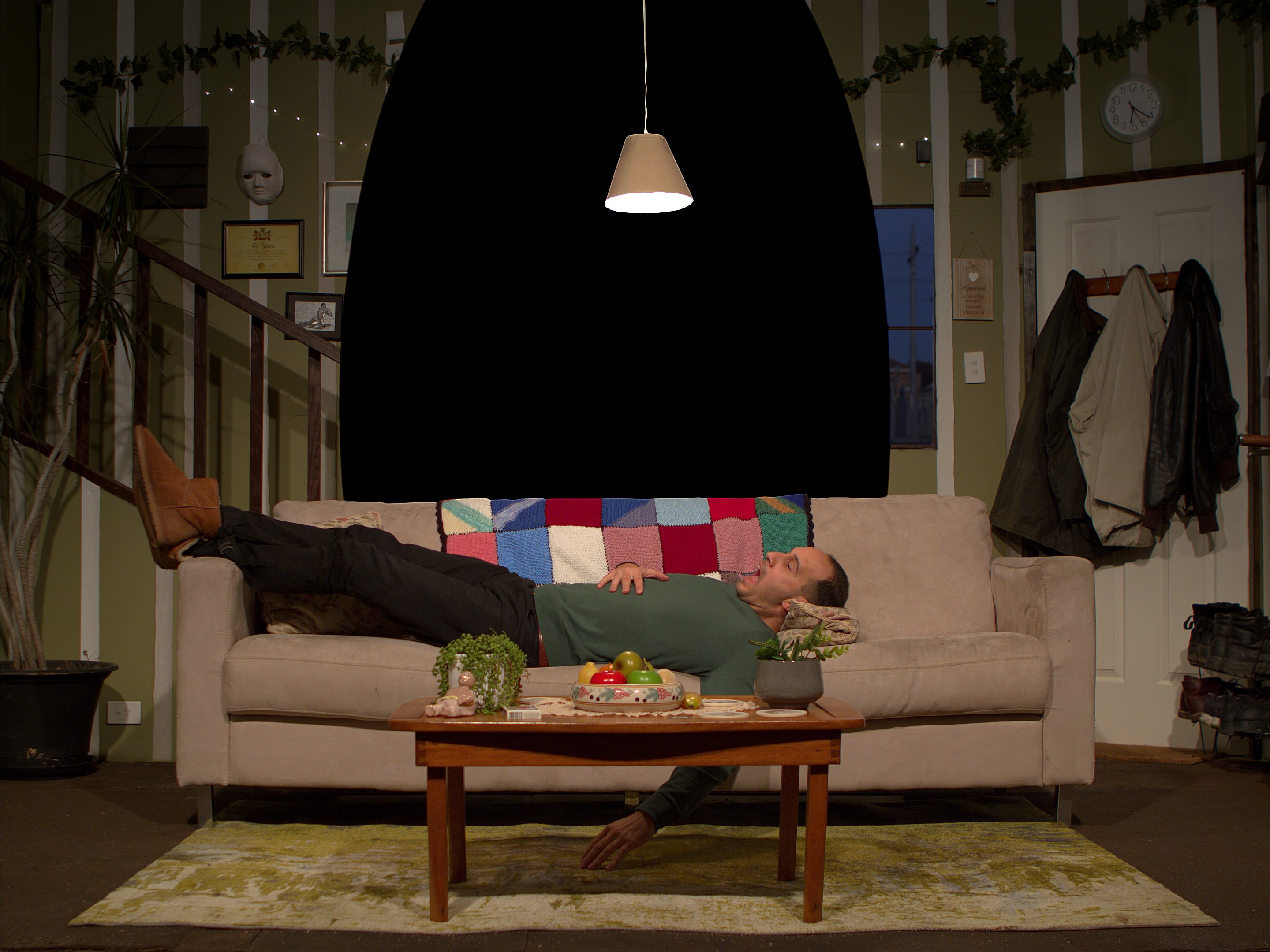
Liam O’Brien’s recent screening of Empty Avenues (Best of Season 1) (2018) at Seventh Gallery was staged in a dim room with two armchairs, a wooden coffee table, a lamp and two portable heaters. As visitors entered this fabricated space, they were faced with a second living room, on screen. The set inside the film is far more kitsch: a cartoon-like fit-out with a green striped wall, a stairwell covered in frames, a couch with a colourful patch quilt, a yellow rug and a palm tree.
Empty Avenues adopts the form of a sitcom compilation, in which a male protagonist and an empty black void live together in a suburban share house. Reminiscent of Friends, Frasier or Will and Grace, the pair act out the well-trodden tropes of the ‘odd couple’ scenario. It’s the type of video we might binge on at 3am — a genre that inspires pleasure and numbness, maybe even guilt, as we let auto play roll on. Yet, beneath this pastiche of 1990s sitcom lies a philosophical question of individual will, explored in earnest in twentieth-century existentialism. What happens when you cross Seinfeld and Camus? What if nihilism was the punchline? Offering an answer to this question, Empty Avenues literalises the Absurd in the animated black void, Lacuna.
The film begins with the introduction of Lacuna, a new housemate to the male protagonist and his uninterested female companion. With a roaring laugh-track in the background, the man explains the rules of the house:
rent is due on the last week of the month
there’s a cleaning roster we’ll put you on but I imagine you're a pretty tidy guy
If Lacuna stands as the void of existence, then he is not a torturer as much as he is a nuisance: a housemate who eats the protagonist’s cheese, takes his gloves, scares (and then seduces) his date.
At three points this comedy is interrupted by a neurotic internal monologue. The first one begins:
Need to exercise more, you can’t afford it, you can’t get fat though. Cut out sugar, eat less. You should get a coffee and a cake. You’ll never own a house. You need to find a new job. I don’t want to go to work.
The entire audio track is recorded in the artist’s voice (although the protagonist is played by another actor), blurring the distinction between character and creator. Echoing previous works, in particular FOE (2016), these monologues are a form of confessional. In the second one, the fictive character appears very close to O’Brien indeed:
Time to grow up get a real job, something people respect, something that actually pays. Money isn’t everything but it certainly makes everything easier. You’re never going to make it in art. Nobody buys video, at least not for very much. Do a painting, make some ceramics, things people actually want. Idiot. You better start selling before your gallery drops you. You’re only as good as your market value. Boohoo have a cry. You got yourself into this mess.
While these passages certainly carry a lot of the work’s existential weight, there is a deeper, structural level at which these ideas play out. Empty Avenues rests on a highly dislocated sense of time. Pilates, cooking, vacuuming, spray-and-wiping, laundry, occasional drug use — these activities recur throughout the film but never reach a conclusion. The protagonist is trapped in the meandering and cyclical time of domestic chores as the demands to cook, clean and make small talk with silent housemates seem as inevitable as life itself. There is no revelation great enough to break the daily cycle. In a number of Truman Show-esque moments, he goes behind the set to discover that the stairs lead nowhere, the fixings of the house are incredibly flimsy and the window is just a painted blue wall. But even these epiphanies lead nowhere. In the next scene he is back to normal life, reading books and cooking ginger salmon.
And yet, sitting against this quotidian time, is the edited time of montage. To speak of a narrative of oneself implies a certain chronology. We seek time that is consistent, linear and that moves towards an endpoint (realised in a lifetime achievement or in death). We reconstruct the past, make explanations for the present and plan for the future. We assign ourselves roles within this framework: hero, prisoner, condemned, redeemed, leader, loser, artist, so on. Empty Avenues refuses any discernible narrative by splicing together various unexplained scenes and partial sequences. The work hints at certain plotlines, such as the thieving housemate or the failed romance, but these are vague and unresolved. As O’Brien narrates in the final monologue:
Life doesn’t lend itself to narrative very well. You either have entertaining fictions or banal facts. New research shows that the brain acts like a video editor: cutting down experiences into more easily memorable stories. When I’m feeling low, I try to convince myself that it’s just my narrative I want to end.
There’s a tension between content and form in Empty Avenues. The staggering, domestic time that the man inhabits might seem stifling but the mutated, montaged time in which we watch him is more unnerving yet. Amelia Barikin has previously argued that O’Brien’s work expresses fear of linear time and of finitude.1 Here, I think we see something quite different: not the angst of chronology but the chaos of life without it.
Empty Avenues does not simply depict absurdism. Rather, it generates the confounding temporality of the Absurd. As defined in existentialism, the Absurd comes in a moment of rupture with the status-quo. We suddenly realise that those qualities we believed to be inherent within ourselves (being-in-itself) are in fact arbitrary fictions that we may rewrite at any time (being-for-itself). The Absurd punctures one's sense of reality and with it unravels linear time. Something very close to this plays out in O’Brien’s film. The protagonist is denied temporal continuity and thus cannot make a story about himself. In the end, the void-cum-housemate seems to be the only stable aspect of the film. Perhaps this points to the greatest fear of all: is existential dread just another stabilising trope in a world without purpose?
Sophie Rose is currently Assistant Curator at the Queensland Art Gallery | Gallery of Modern Art (QAGOMA).
